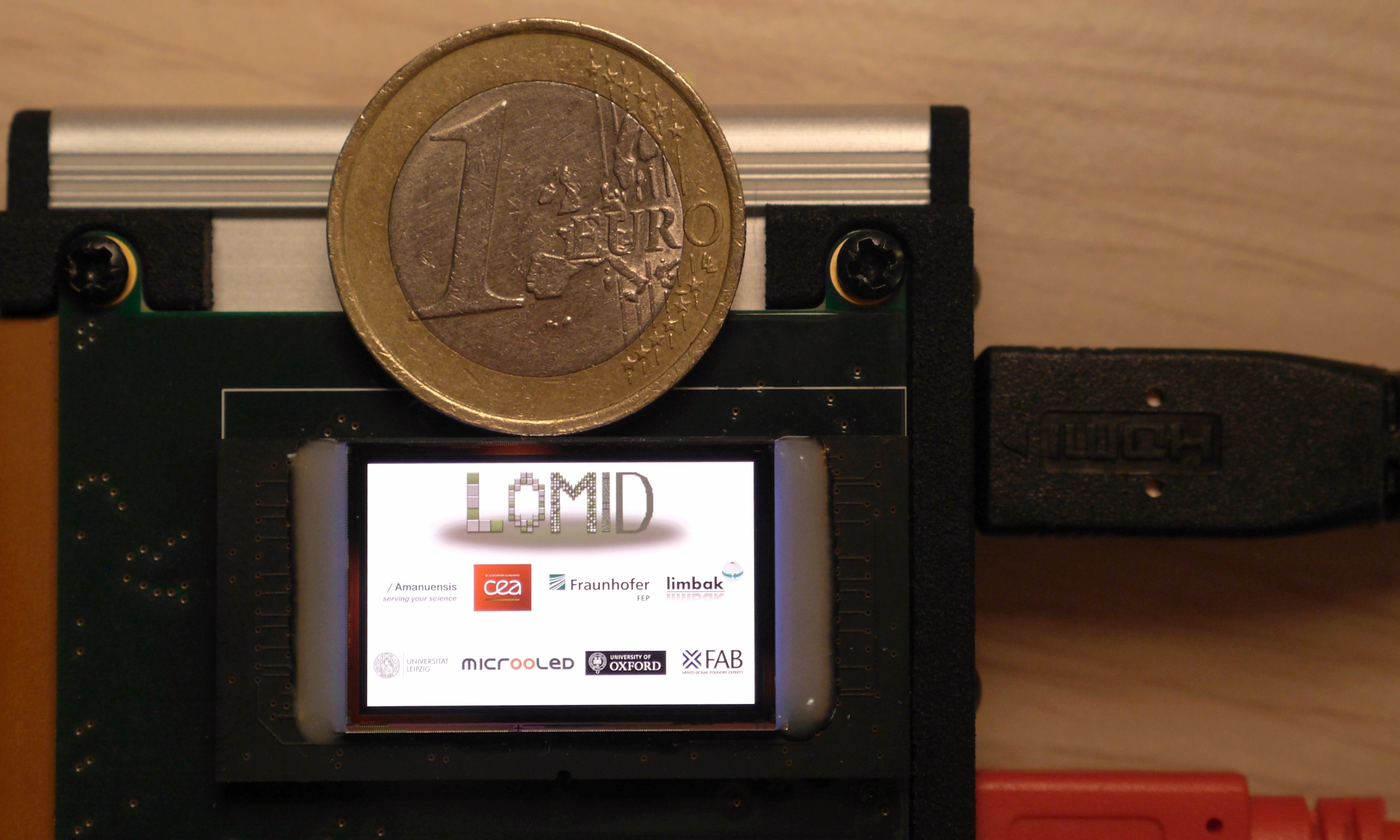24 | 2017 – Novel microdisplays will benefit blind users
The EU-funded research project ‘LOMID’, led by the Fraunhofer FEP, has fabricated a new generation of microdisplays with 1-inch diagonal and WUXGA resolution (1920 x 1200 pixels) – requiring a pixel density of 2300 ppi. The project team has also shown, for the first time, that it is possible to bend such displays to radii of just 40 mm after thinning the substrate. Such thin, flexible displays save weight, but also allow novel optical designs to be used – especially important for accuracy when large fields of view are used in compact optical designs.



The new displays, which use OLED-on-CMOS technology for bright, high contrast images (>100,000:1), have a much higher pixel density than e.g. smartphone displays. They are larger and with many more pixels than existing microdisplays, making them better for use in applications such as ‘smart glasses’ and VR headsets, as well as for electronic viewfinders in cameras and for head-up displays. One application for the new displays that the project team will test is in prosthetics for people with impaired vision (often legally classed as blind).
Over two million people in Europe suffer from macular degeneration, an age-related condition in which sufferers have only peripheral vision. The new wide microdisplays are particularly well suited to help these people, when used with compact optics and integrated with a camera in ‘smart glasses’. Image processing software is used to provide an enhanced video view of the surroundings that exploits the remaining vision so that, with training, ‘blind’ people can safely navigate and interact with their surroundings. The LOMID project team will test the new ‘smart glasses’ with blind volunteers in early 2018.
The projection of images to the peripheral vision is also very important in providing a sense of realistic immersion for virtual reality (VR) applications. Such applications also benefit from the very high frame-rate possible with the new chips (120 Hz), which helps to minimize ‘motion sickness’ effects that can arise with VR systems. The project has designed the chips in conjunction with novel optics using the ThinEyes® technology patented by Limbak, one of the industrial partners in LOMID. The novel optical train enables the use of multiple display chips per eye in a VR system, featuring fields of view of over 100° (providing a truly immersive experience) with high resolution and increased comfort. The resolution achieved of 24.6 pixels per degree is more than good enough to watch HD movies in VR, and the new VR goggles will be just one quarter of the size and half the weight of existing VR headsets.
Dr Uwe Vogel of the Fraunhofer FEP, leader of the LOMID project, believes that “The combination of the new microdisplays and optical design will result in a huge leap forward in the comfort and acceptance of VR goggles. The application of the displays in visual prosthetics is also very exciting, and could improve the quality of life for millions of people in Europe and around the world”.
The project team recently completed manufacture of its first fully specified microdisplay chips, and is now testing them and using them to build several demonstration systems for VR and visual prosthetics - the demonstrators are expected to be available to potential customers from Q1/2018. Some components from the project will be demonstrated at the European Forum for Electronic Components and Systems EFECS in Brussels, from 5th to 7th December. The microdisplays developed by the project will be available commercially from the company MICROOLED.
About the LOMID project
The LOMID research project, running from January 2015 to June 2018, involves eight partners from five countries. Four of the partners are research institutions or universities: The Fraunhofer Institute for Organic Electronics, Electron Beam and Plasma Technology FEP contributes to the microdisplay backplane IC design and prototyping; the University of Leipzig synthesized materials for transparent oxide transistors; the University of Oxford will address vision aid applications; and the French Commissariat à l’énergie atomique et aux énergies alternative (CEA) Leti developed techniques to allow the displays to be bent. The industrial partners are the silicon foundry X-FAB, responsible for CMOS chip manufacture; MICROOLED, responsible for microdisplay manufacture and commercialisation; Limbak, responsible for the design of high performance optics and Amanuensis, supporting project management.
The LOMID project has received funding from the European Union’s Horizon 2020 research and innovation programme under grant agreement No 644101. This work was also supported by the Swiss State Secretariat for Education, Research and Innovation (SERI) under contract number 15.0035-1; the opinions expressed and arguments employed herein do not necessarily reflect the official views of the Swiss Government.
See also: www.lomid.eu
For further information, contact:
Dr. Uwe Vogel (leader of the project):
uwe.vogel@fep.fraunhofer.de (Phone +49 351 8823-282)
Dr. James Whitby (publicity manager)
james.whitby@amanuensis.ch (Phone +41 3812726)


 Fraunhofer Institute for Electron Beam
Fraunhofer Institute for Electron Beam